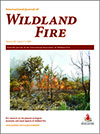International Journal of Wildland Fire
Volume 30
Number 11 2021
Disastrous spring wildfire seasons continue to occur in Alberta, Canada, despite full suppression efforts to contain them. Two synoptic weather patterns were identified associated with those days when very high wildfire spread occurred. Wildfires in May are wind-driven events characterised by very high to extreme Fine Fuel Moisture Code (FFMC) and Initial Spread Index (ISI).
Fire activity in the Andes has increased significantly. This study explores the conditions conducive to forest fire in the Andes of Peru. Our findings indicate that climatic parameters such as cumulative precipitation, dry-day frequency and hot-day frequency are statistically associated with conditions that could contribute to increased forest fire occurrence.
Techniques new to wildland fire occurrence prediction (FOP) were used to create well-calibrated bagged classification trees, random forests and neural networks. These models were used for spatially explicit, human-caused daily FOP in the Lac La Biche region of Alberta, Canada, and compared with calibrated logistic regression and calibrated logistic generalised additive models.
This study looks to identify the variables that characterise fuel loads of dead and down woody debris across Canadian forests, using a compilation of datasets. These data were used to examine the geographic variability in woody debris fuel loads across the country and to determine which factors most significantly influence fuel loading.
In the context of fire management in a desert of Western Australia, we compared fire scars generated with data from three different satellites. Our results indicate that Landsat-derived fire scars are the most appropriate product to generate reliable fire history maps to inform fire management and biodiversity conservation operations.
Rapid growth is the most important attribute in cerrado trees to avoid canopy and stem death due to fire. Tall trees (height ≥ 3.7 m) commonly recover by resprouting from the stem (59% of trees), whereas short trees (diameter ≤ 5 cm) tend to resprout from the base (25%).





